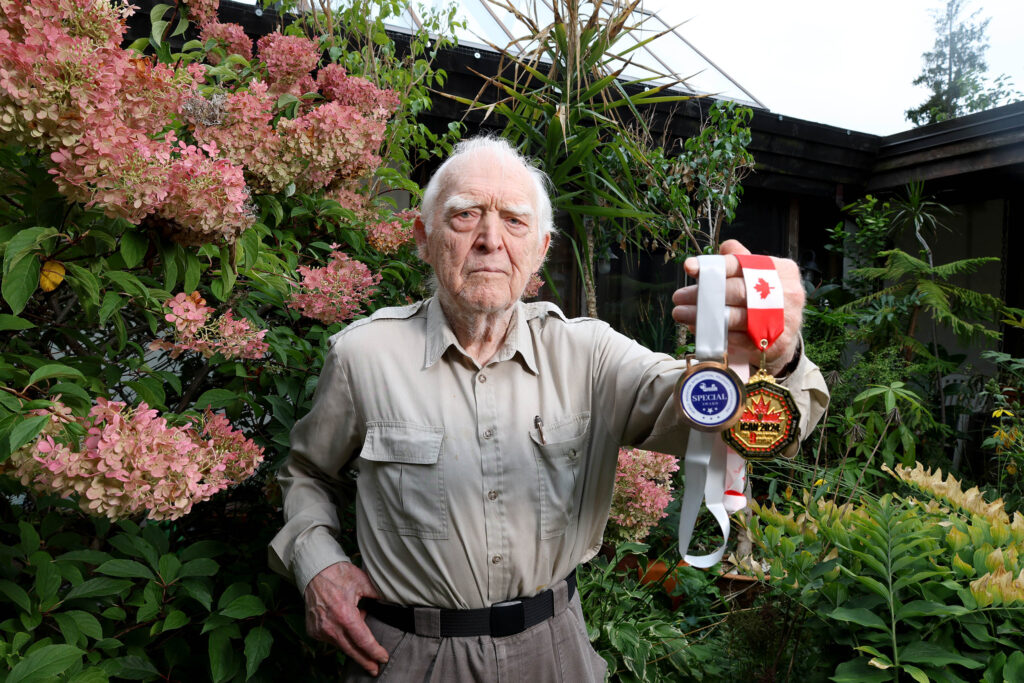An old invention from the 1970s wins a modern innovation prize for this CivMin alumnus;
showing resilience and perseverance pays off repeatedly over his lifetime as an inventor and entrepreneur

In what would otherwise appear to be a tale of science fiction from the 1970s, an alumnus has been awarded a very modern prize for invention and design of a space-age structure.
Lembit Maimets (CivE 5T6) has won first place with the International Special Award for his entry of “Self-unfolding satellite with gravity” from the World Invention Intellectual Property Association (WIIPA). Additionally, a special honour was given from the Association of Thai Innovation and Invention Promotion (ATIP). The announcement came at the International Invention Innovation Competition in Canada (iCan 2024).
“It was quite a surprise – I didn’t expect it,” remarks the inventor and entrepreneur.
Long-term perseverance is somewhat of a recurring trend with Maimets, who recently turned 98, throughout his academic and professional career. The design was conceived, and patented, in the 1970s. He remarked it was essentially forgotten and left for so long, “The patent has now expired – back in 1993 I think. When I was asked to enter something in this contest, I just remembered it and took it out to enter.”
Essentially a hollow doughnut
Essentially, in very simple terms, the structure he has designed is a large, hollow doughnut with an elegant and simple method for deployment in space.
Maimets explains how his compact package can expand itself, “It is something that uses the internal stresses in the material, so that when in zero gravity, the stresses are released, the structure becomes a doughnut, basically. And that’s it by itself. Then people get into it afterwards, do whatever they have to do to set it up so that astronauts can live in it to make a habitable structure. One of those doughnuts can accommodate about 800 people, and you can stack them up. I would say that in the whole drum, maybe 10,000 people can be there. The power can be with a nuclear power system.”


One of the main benefits of the structure’s design is it can offer Earth-like gravity when spinning around its axis. This concept allows for long-lasting space voyages, as it enables astronauts to maintain muscle and bone density with the simulated gravity constantly in operation. Further, stacking and connecting the structures allows for far greater occupancy and payload as necessary for a long journey.
New beginnings
The Estonian-born inventor and entrepreneur had started studies in Germany after the Second World War, but found the country uninviting to outsiders. Soon after, he came to Canada in 1947. Though he wanted to immediately return to his engineering studies, Maimets had to first find work. Putting great physical effort into his job with Ontario Hydro, Maimets earned enough to return to his studies with Civil Engineering at U of T in 1949.
His return, though, was short lived, “I failed my second year and had to work before I came back. I had no question; I had to finish – this was my goal.”
“I did everything I had to do.”
Once more persevering in maintaining his goal, he says, “I did everything I had to do – I cleaned offices at night, sold meat at a grocery store counter, set up bowling pins.” Working while attending school, he says, “Of course, I didn’t have time to sleep, so I slept in the streetcar in those days. Yeah, it was quite a quite an interesting experience.” Then, triumphantly recounts,”Finally, I made it.” His tenacity had, once again, paid off.
After graduating, he spent another 14 years (giving 20 in total) performing municipal engineering work with municipalities in the Greater Toronto Area (GTA), 10 years as a consulting engineer designing high-rise structures, over a year at the National Research Council (NRC) Canada on its Associate Committee on National Building code and the last 44 years managing Link-Pipe Inc. Maimets recounts, recounting more milestones of his professional career, “I did the structural design as freelancer through Huebank Billar and architect Adams, the first phase of U of T Scarborough campus building. Before leaving City of Toronto Buildings Department, l was the owner’s structural engineer, not the designer, in charge of the new City Hall. I also was the structural engineer for South-Central and Gateway new automated post offices while working for Cole Sherman Consulting Engineers managing the post office project. I left the position of Director of Buildings in Scarborough 1971.”
Professionally, Maimets is known for founding a company of his own. As president and CEO of Link-Pipe Inc., a manufacturer of no-dig pipe repair products first established in 1980, he has multiple patents for repairing pipes and conduits. Recently, as a move towards retirement, he closed the business on July 31 and licensed his technology to companies in the Middle East and Africa, with a view to expand licensing to Europe and Singapore.
“I have worked on all five continents except the South Pole. It has been very interesting travelling to places like Asia, Australia, New Zealand, Russia, Europe and the Middle East, of course. That’s been very interesting and excellent.”
Our alumnus continues to exude the energy and tenaciousness of a lifelong learner. He repeatedly, and steadfastly, refused to let his setbacks deter him from pursuing his goals; an example to us all.
VIDEO: Watch the voiceover PowerPoint explaining the concept:
By Phill Snel